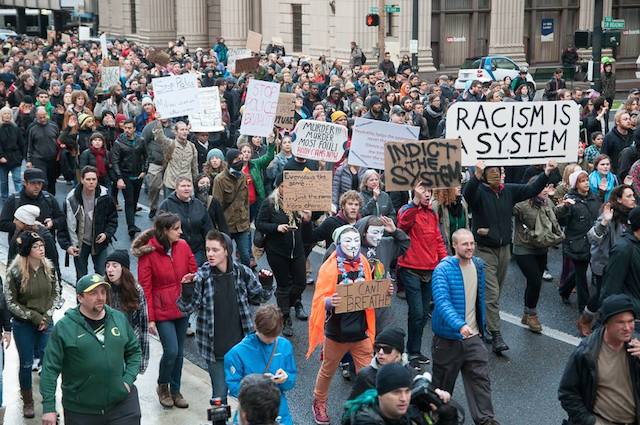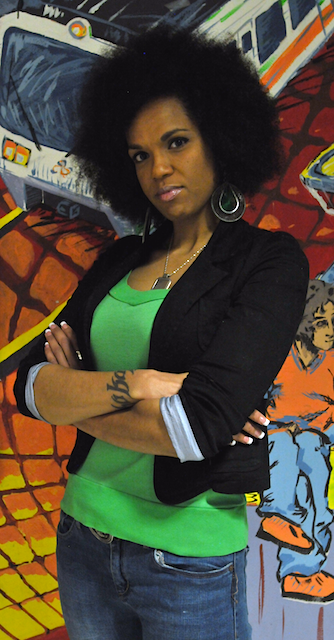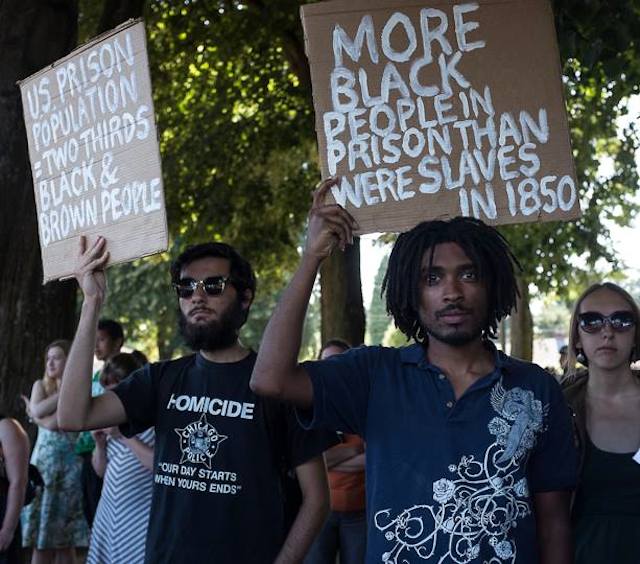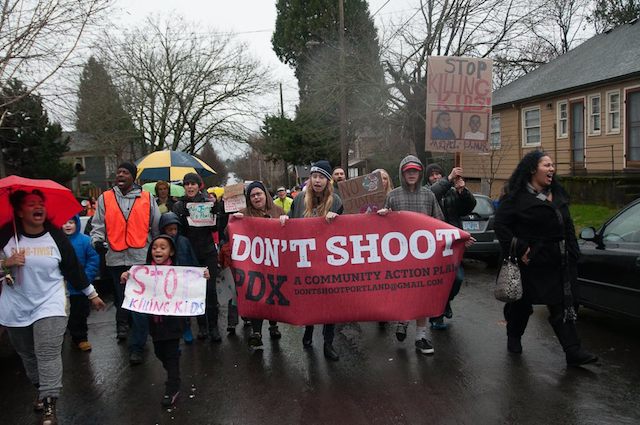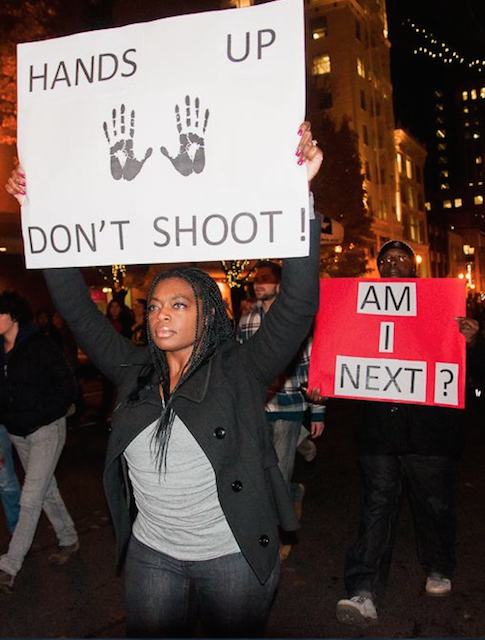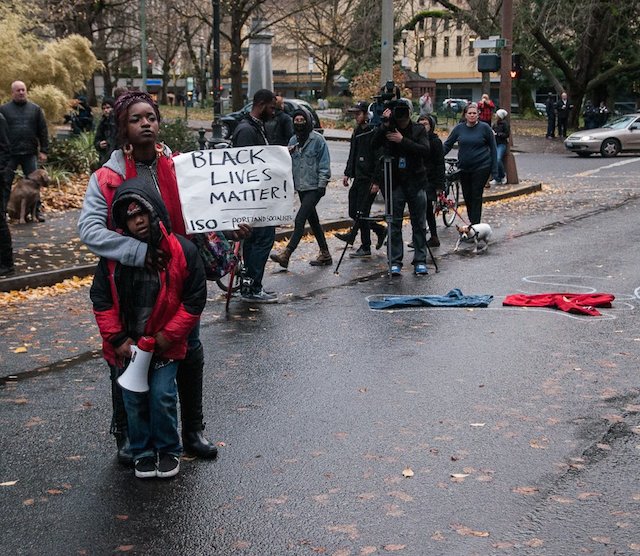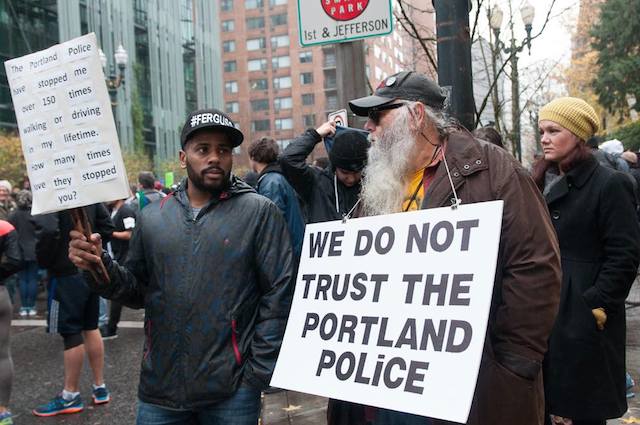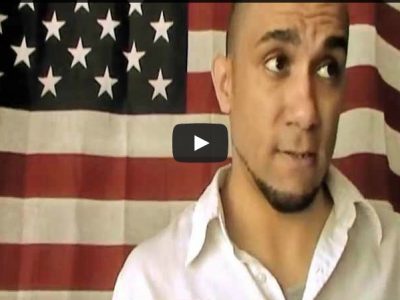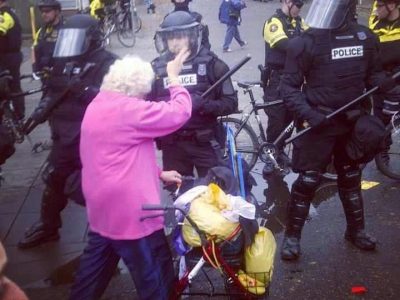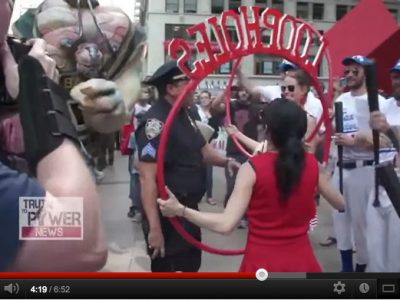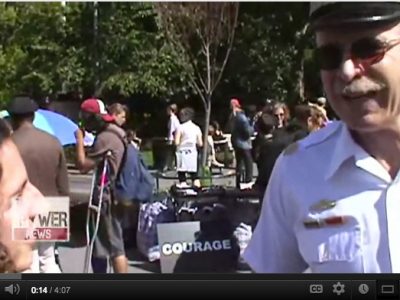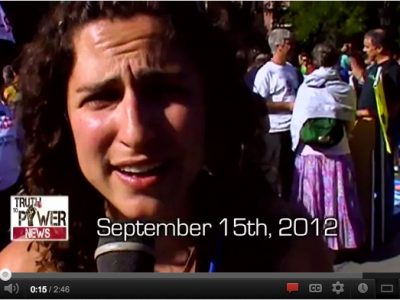Story by Pete Shaw
Walidah Imarisha was winding down a late November presentation about alternatives to police and prison at Portland Community College when a person in the audience announced the failure of a Ferguson, Missouri grand jury to indict Officer Darren Wilson for murdering Michael Brown. Imarisha paused, then shook her head. “I’m disappointed,” she said, her voice heavy with emotion. “Incredibly disappointed. But not surprised.”
In an interview with ABC’s George Stephanopoulous in the aftermath of the decision, Wilson stated that he had a clear conscience about killing Brown because “I know I did my job right.” What Stephanopoulous–and all of the corporate media–have consistently failed to ask is just what is the job of the police?
That question forms the crux of Imarisha’s presentation Maroons, Political Prisoners, and Abolitionist Dreams. Imarisha, a writer and educator who also presents the informative Why Aren’t There More Black People in Oregon?: A Hidden History, argues that Wilson is correct when he says he did his job right, because his job–as with all police–has always been “the control, containment, and exploitation of potentially rebellious communities…who could challenge or overthrow the state.” Throughout US history, those who have most often been subject to police violence have been people of color, particularly Black people.
The importance of Imarisha’s subject has become readily apparent over recent weeks. On December 3, a grand jury in New York City failed to indict Officer Daniel Pantaleo for the chokehold death of Eric Garner in July. This despite Pantaleo being caught on video applying the chokehold as Garner says 11 times that he can’t breathe. All because Garner was apparently selling single cigarettes. For those who perhaps have wondered what a lynching looks like, the video provided a textbook example. As Michael A. Gonzales wrote in a recent article in Ebony, “it’s becoming harder every day to separate the lynching culture of pre-Civil Rights America from our postmodern police state.”
Since Brown’s murder, numerous Black people have been shot and killed by police, and it could be a safe bet that those police also will not be indicted. It is difficult to assess the actual number of people police kill, because many police forces do not voluntarily turn over this information; however, by one estimate, as of December 23, police had killed 1,073 people this year.
Summing up a study by the Center for Disease Control and Prevention, Carimah Townes and Dylan Petrohilos wrote “people who belong the marginalized communities are at a higher risk of being shot than those who are not.” Meanwhile, an analysis by ProPublica shows that between 2010 and 2012 young Black males were 21 times more likely than young white males to be murdered by police. As the ProPublica article concludes, police are killing Black people “at disturbing rates when set against the rest of the American population.”
While Michael Brown and Eric Garner may have become household names, it is important to remember that all the victims of police had names: Tanisha Anderson. Xavier McDonald. Michael D. Sulton. Thurrell Jowers. Tamir Rice. Akai Gurley. Keara Crowder. John Crawford III. Dontre Hamilton. Those are just a scant few of the names on a nauseatingly long list of people, beloved by families, friends, and communities, too soon gone at the hands of police.
When not justifying police killings–as the New York Times had it, Michael Brown “was no angel”–corporate media treats them as isolated incidents, the result of a few bad apples. This type of individualized analysis consistently misses the big picture. At a minimum, if these murders were the result of a few bad apples, one might expect the good apples to come forth and demand justice. Instead, in another display of the white supremacy that is integral to policing, we see police unions demanding apologies from football players on the St. Louis Rams and Cleveland Browns football teams for expressing their desire for justice. In New York City, the police union is considering banning the mayor from police funerals because he has refused to bend to their version of history.
This is not a barrel with a few rotten apples. The whole barrel is putrid. The system is broken.
Or as Imarisha has it, the system is working exactly as it is supposed to.
“We treat these cases as isolated incidents, rather than saying these killings of Black people are happening every 28 hours and that there is clearly something institutional and foundational supporting this behavior,” she says, citing the Malcolm X Grassroots Movement’s 2012 Annual Report, which found that the killing of an unarmed Black people by police or armed white vigilantes is literally a daily occurrence in the US.
We are taught to view the police and the prison system superficially: Our jails are filled with criminals, and criminals by definition are bad. Police arrest criminals, and their job is to protect us from people who would do us harm. We know this because we are told it, both in formal settings such as newspapers and television news, or in other forms such as movies and television. Start scratching the surface of this tale and something much uglier takes form.
Largely hidden in the dominant narratives and texts is a far different story that belies treasured myths. “We can’t begin to understand what has happened and what is happening in Ferguson without putting it in a long-term context,” Imarisha says. “We are given information that is at best misleading and at worst outright false.”
In the United States there are 2.3 million people in jail and another 5 million people under the prison system’s thumb through probation, parole, house arrest, or mandatory drug treatment programs. Land of the free? Neither China, nor Russia, nor any official enemy state considered to stand against our shining light of freedom can be fingered as having the most incarcerated people in the world. The US is #1.
Why are these people imprisoned? About 60% of them are in jail for non-violent offenses, a number that leaps to 92% when confined to the federal system. Yet violent crime has decreased by 46% in the past 19 years–a rate closer to the 1950s era.Drugs are the primary factor that leads to prison time for first-time offenders. Prior to the war on drugs, which began under President Nixon in the 70s and was significantly ramped up by Reagan in the 80s, such prisoners were rare. In fact, 70% of today’s prisoners would not be in jail prior to the war on drugs. Furthermore, about 90% of these first time offenders took plea bargains instead of facing trial. In other words, they were convicted by a prosecutor, not a jury.
The drug war was hardly a war on drugs. It was a war on people of color, particularly Black people. Seventy percent of prisoners are people of color and of those, 50% are Black. In Oregon, and the US generally, Black people are six times more likely than white people to go to prison. Yet in terms of drug crimes, white people are either as likely or slightly more likely to be in possession of illegal drugs. As Imarisha shows, 65% of drug users are white, while only 14% are Black. Yet Black people make up 35% of arrests, 55% of convictions for drug related crimes, and 74% of those serving time for drug sentences.
Those are some uncomfortable facts. But why are they so?
Imarisha asserts that to understand these statistics, people need to realize that our current policing system arose out of the slave patrols of the antebellum US. Imarisha cites scholar Kristian Williams’ book Our Enemies in Blue: Police and Power in America which traces the current policing structure back to government-organized slave patrols like those in North Carolina. Those slave patrols stopped enslaved Black people from escaping slavery, protecting the master class’ property, while also working to keep a lid on potential rebellions. Their job, no different from today’s police, was to contain resistance to–and rebellion against–the status quo. Their violence was sanctioned by the state, and they were rarely, if ever, held accountable.
Following the Civil War, however, slavery was abolished and the slave patrols rendered obsolete.
Sort of.
The 13th Amendment to the Constitution does not, contrary to what we are told, abolish slavery. Section 1 reads, “Neither slavery nor involuntary servitude, except as a punishment for crime whereof the party shall have been duly convicted, shall exist within the United States, or any place subject to their jurisdiction.” (italics mine)
Imarisha notes that the first prison boom in the US, not coincidentally, began right after the 13th Amendment was ratified. “Systems of control that start with slavery shift into prisons,” she says. The southern economy, once dependent upon slave labor, now sought other means to regain free labor. “The majority of white people were saying they wanted Black people back on the plantation.”
Southern states crafted Black Codes to restrict the freedom of newly freed Black people, including a variety a vagrancy laws–only applied to Black people–that worked hand in glove with laws allowing state prisons to hire out convicts for labor. Where slavery had once been a means to control, contain, and exploit Black people, prisons now served the same function.
But if there is a direct line between slavery and modern police and prisons, there is also one of resistance to these institutions. Imarisha is quick to remind people that resistance during slavery was not limited to rebellions such as that of Nat Turner. “The majority of resistance to slavery happened every single day.” Such acts of defiance included breaking tools, purposely injuring oneself, poisoning the food of the master and his family, and in its most powerful form, just leaving.
That resistance continued after 1865. Imarisha presents a list, not exhaustive, of 17 prison uprisings right up to the recent California Prisoners’ hunger strike. Outside of the walls of jails, the most glaring example of resistance was the Black Panther Party, which FBI Director J. Edgar Hoover once declared “the greatest threat to internal security in America.” The party’s greatest crime, according to Hoover? Its free breakfast program–a program that was subsequently duplicated by the federal government in public schools across the nation.
For their resistance, Imarisha says, the federal government “used every illegal tactic possible to attack the Black Panther Party and destroy it.” Some, such as Fred Hampton, were murdered. Others comprise some of the 100 political prisoners from the Third World liberation movements era–Blacks, Native Americans, Puerto Ricans, Chicanos, and anti-imperialism whites–held under utterly repressive and inhuman conditions for, as Imarisha describes it, “the act of feeding children.”
It is becoming apparent that if we don’t want police violence, we are going to have to get rid of police as we understand the institution, as well as the prisons that work hand in glove with current policing. They are dangerous institutions, violent at their cores, and built on racism. Reform is no more the answer here than it was during the slavery era when, it was popularly argued in some quarters (Abraham Lincoln was himself once an advocate) that slavery should be reformed rather than abolished. So too, the fight against fascism in WWII was not ultimately an effort at reform, but rather a movement to destroy it. And so it should be with police and prisons.
“Prisons have to fundamentally be eliminated,” states Imarisha. “Prisons make us less safe and they make us less human. We have to build structures that focus on addressing harm and healing communities, rather than upholding oppressive structures and punishing.”
But how?
The answers are a lot more available than many might think. For example, Imarisha asks, what if drug problems were treated as a health crisis rather than a criminal justice issue? Instead of arrests, prosecutions, and prison sentences, what if we focused on treatment and counseling? We know from experience there is a direct relationship between prohibition and violence. Tobacco is legal and consequently there is little violence associated with its production and sale. The prohibition of alcohol in the early 20th century unleashed a swathe of violence.
Imarisha notes that one example of an alternative to criminalization is the drunk at a party scenario. Do people usually call the police to handle the situation? Very often, they call a taxi or arrange for someone sober to drive him home. “That,” declares Imarisha, “challenges the criminalization framework.”
Of course, a great deal depends on how much money a drug user possesses. Very few rich people caught with drugs face jail time; instead they go to the Betty Ford Clinic or one of the many other drug rehabilitation centers beyond the financial means of most people.
What about people who commit violence against another? Imarisha cites the Baltimore-based Community Conferencing Center, which works to address serious harm through community mediations. For crimes including auto theft, assault and property destruction, this rigorous program brings together “victims, offenders and their respective supporters” to discuss the crime, how that crime has affected both the direct victims and the community, and how to “resolve the matter and prevent it from happening again.”
As an example of the program’s effectiveness, a study by the Maryland Department of Juvenile Services showed that “young offenders who participated in Community Conferences re-offend 60% less than a comparable sample of young people who went through the juvenile justice system.” Furthermore, of the approximately 6,500 youth who were referred to Community Conferences in that time span, about 98% came to an agreement with their victims and the community, and about the same percentage complied with their agreements.
Due largely to the courageous and difficult organizing work of young Black people—really, one of the most inspirational stories to come out of the burgeoning movement against police violence–these ideas of alternatives to police are no longer on the fringe. Rolling Stone recently published an article presenting 6 ideas for a “society that isn’t dominated by police.”
In larger terms, Imarisha asks people to consider how different things could be if, instead of focusing on criminalizing people, we instead addressed the inequalities that exist in our country. Housing support? Better education?
This shift requires the imagination of a different world. A common refrain is that our mode of government, no matter how arcane, byzantine, and conservative it may be, is still based on democratic institutions that can be made to serve the purposes of the many instead of the few. But if Imarisha is correct that the policing and prison system, founded upon racism and violence, works exactly as it is supposed to, it is hard to support such a belief.
Reality shows that these so-called democratic institutions do not work very well for most people. Nor were they meant to. The Constitution was drawn up by a small group composed of white men, many of whom owned slaves. The eventual signers defined slaves as 3/5 a human. That fractional relationship emanated from over a century of institutionalized chattel slavery in a land that itself was violently seized from an indigenous population. Our country was founded in violence and depended heavily on slavery and its accompanying racism–the latter which still plagues us today and is still deeply embedded in the country’s foundation.
So what to do? For starters, imagine a world without its current institutions that oppress by design. In some places that world already is beginning to find form. The only thing holding us back from a world without police and prisons is our imagination and our will.
Imarisha writes science fiction. Writing such material requires the author to create that which does not exist in this world and to do so in a manner that convinces readers it is real. Less than 200 years ago, if you talked about a future United States without chattel slavery, even those who abhorred slavery might have considered you delusional at best. Still, they organized and fought for their vision of the impossible. For those people who imagined–against all odds–a country without chattel slavery, Imarisha says, “I’m their science fiction dream.”
“All social change is absolutely unrealistic,” says Imarisha. “If we only focus on what’s realistic, we will never see the world we want to see.”
For information on Walidah Imarisha’s presentation schedule, visit her webpage at: www.walidah.com

